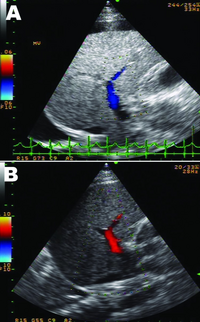Liver failure
| Liver failure | |
|---|---|
| Other names: Hepatic insufficiency, liver dsyfunction | |
 | |
| A person with massive ascites and caput medusae due to cirrhotic liver failure | |
| Symptoms | abdominal inflammation, fluid retention, hyperglycemia, nausea, vomiting, jaundice, acute or chronic fatigue, hyponatremia, hypokalemia, respiratory alkalosis, metabolic acidosis, bilirubinuria, glycosuria, pruritus |
| Risk factors | Excessive consumption of alcohol, fatty foods; obesity; Type 2 Diabetes; sharing or reusing syringes; having tattoos or body piercings |
Liver failure is the inability of the liver to perform its normal synthetic and metabolic functions as part of normal physiology. Two forms are recognised, acute and chronic (cirrhosis).[1] Recently, a third form of liver failure known as acute-on-chronic liver failure (ACLF) is increasingly being recognized.[2]
Acute

Acute liver failure is defined as "the rapid development of hepatocellular dysfunction, specifically coagulopathy and mental status changes (encephalopathy) in a patient without known prior liver disease".[3]:1557[4]
The disease process is associated with the development of a coagulopathy of liver aetiology, and clinically apparent altered level of consciousness due to hepatic encephalopathy. Several important measures are immediately necessary when the patient presents for medical attention.[5] The diagnosis of acute liver failure is based on a physical exam, laboratory findings, patient history, and past medical history to establish mental status changes, coagulopathy, rapidity of onset, and absence of known prior liver disease respectively.[3]:1557
The exact definition of "rapid" is somewhat questionable, and different sub-divisions exist, which are based on the time from onset of first hepatic symptoms to onset of encephalopathy. One scheme defines "acute hepatic failure" as the development of encephalopathy within 26 weeks of the onset of any hepatic symptoms. This is sub-divided into "fulminant hepatic failure", which requires onset of encephalopathy within 8 weeks, and "subfulminant", which describes onset of encephalopathy after 8 weeks but before 26 weeks.[6] Another scheme defines "hyperacute" as onset within 7 days, "acute" as onset between 7 and 28 days, and "subacute" as onset between 28 days and 24 weeks.[3]:1557
Chronic
Chronic liver failure usually occurs in the context of cirrhosis, itself potentially the result of many possible causes, such as excessive alcohol intake, hepatitis B or C, autoimmune, hereditary and metabolic causes (such as iron or copper overload, steatohepatitis or non-alcoholic fatty liver disease).
Acute on chronic
"Acute on chronic liver failure (ACLF)" is said to exist when someone with chronic liver disease develops features of liver failure. A number of underlying causes may precipitate this, such as alcohol misuse or infection. People with ACLF can be critically ill and require intensive care treatment, and occasionally a liver transplant. Mortality with treatment is 50%.[7]
See also
References
- ↑ O'Grady JG, Schalm SW, Williams R (1993). "Acute liver failure: redefining the syndromes". Lancet. 342 (8866): 273–5. doi:10.1016/0140-6736(93)91818-7. PMID 8101303. S2CID 21583699.
- ↑ Arroyo, Vicente; Kamath, Patrick; Moreau, Richard; Jalan, Rajiv (2016). "Acute-on-Chronic Liver Failure: A Distinct Clinical Condition". Seminars in Liver Disease. 36 (2): 107–108. doi:10.1055/s-0036-1583287. PMID 27172350.
- ↑ 3.0 3.1 3.2 Sleisenger, edited by Mark Feldman, Lawrence S. Friedman, Lawrence J. Brandt; consulting editor, Marvin H. (2009). Sleisenger & Fordtran's gastrointestinal and liver disease pathophysiology, diagnosis, management (PDF) (9th ed.). St. Louis, Mo.: MD Consult. ISBN 978-1-4160-6189-2. Archived (PDF) from the original on 2016-03-03. Retrieved 2022-04-07.
- ↑ Munoz, SJ; Stravitz, RT; Gabriel, DA (2009). "Coagulopathy of acute liver failure". Clinics in Liver Disease. 13 (1): 95–107. doi:10.1016/j.cld.2008.10.001. ISSN 1089-3261. PMID 19150314.
- ↑ "EASL Clinical Practical Guidelines on the management of acute (fulminant) liver failure" (PDF). Journal of Hepatology. Archived from the original (PDF) on 24 October 2018. Retrieved 30 May 2017.
- ↑ Sood, Gagan K. "Acute Liver Failure". Mescape. Archived from the original on 10 May 2019. Retrieved 14 December 2011.
- ↑ Sarin, Shiv Kumar; Choudhury, Ashok (17 October 2016). "Acute-on-chronic Liver Failure". Current Gastroenterology Reports. 18 (12): 61. doi:10.1007/s11894-016-0535-8. PMID 27747458. S2CID 29435525.
External links
| Classification | |
|---|---|
| External resources |